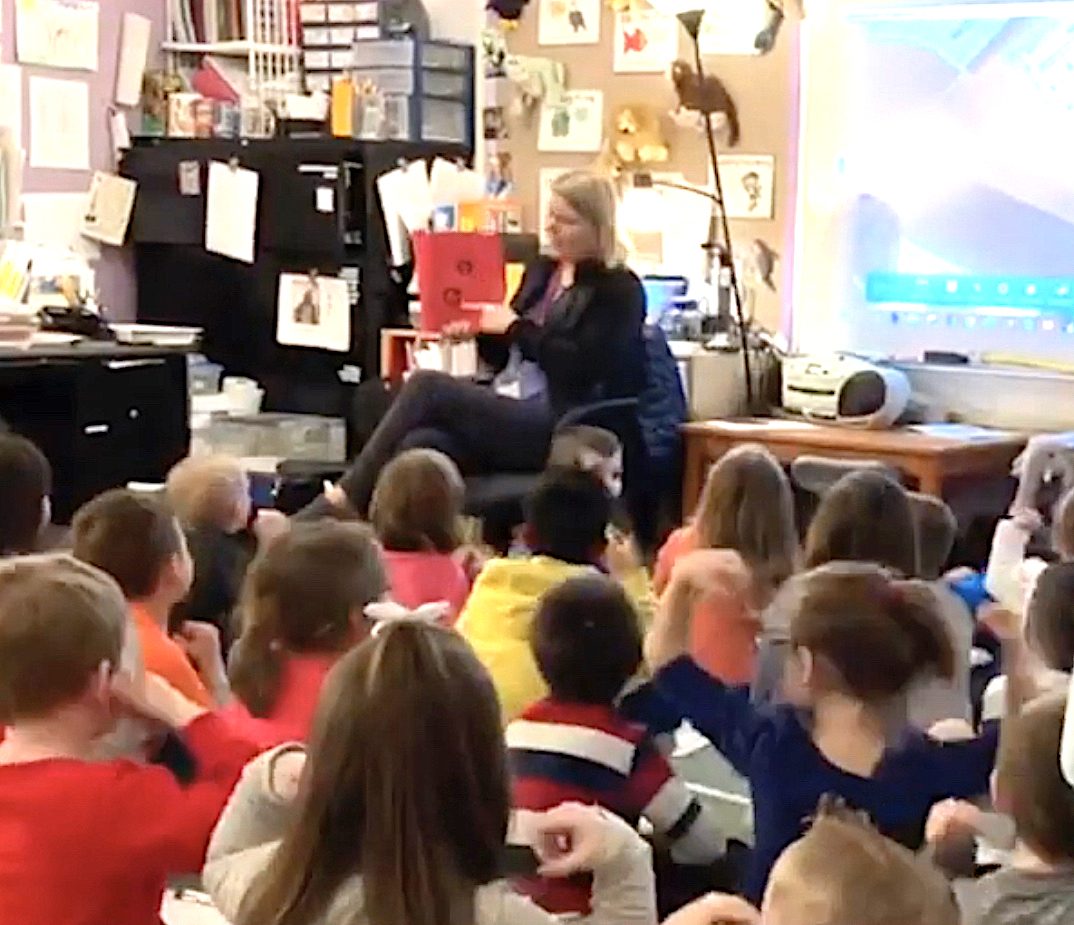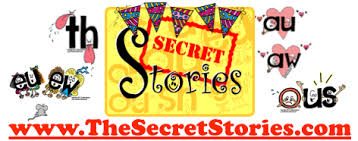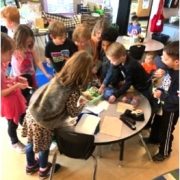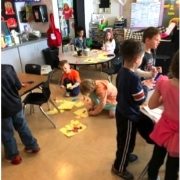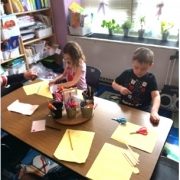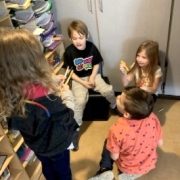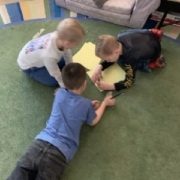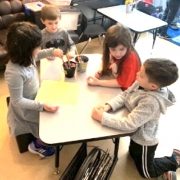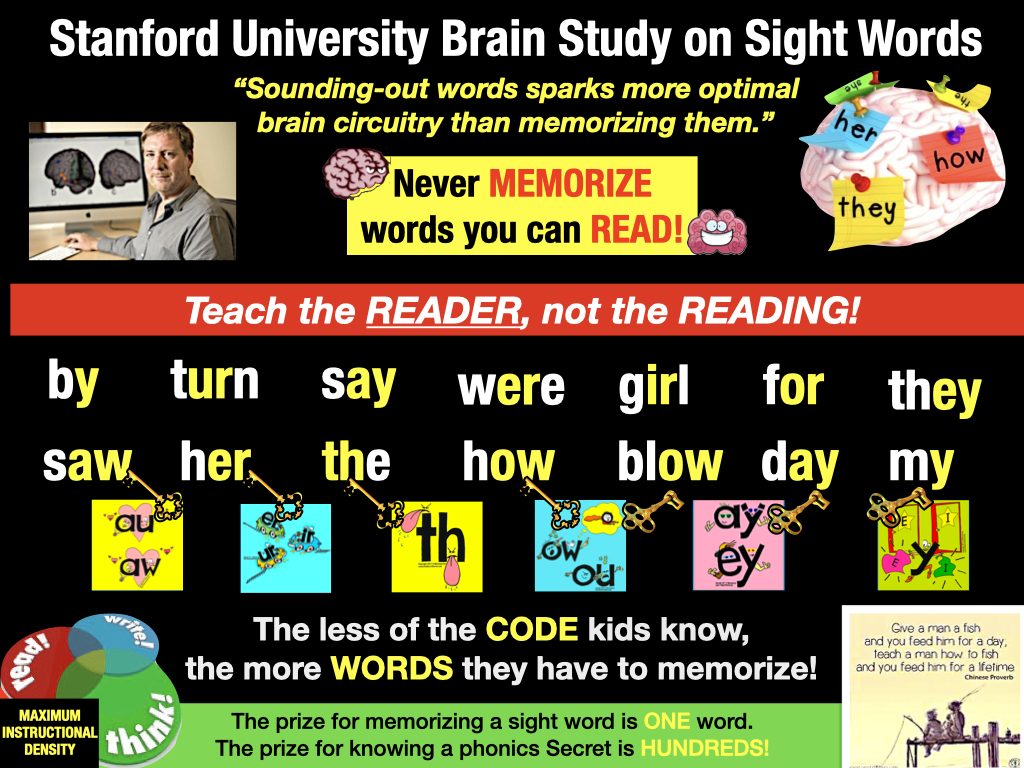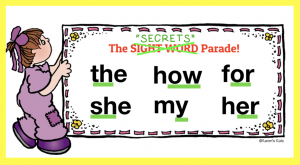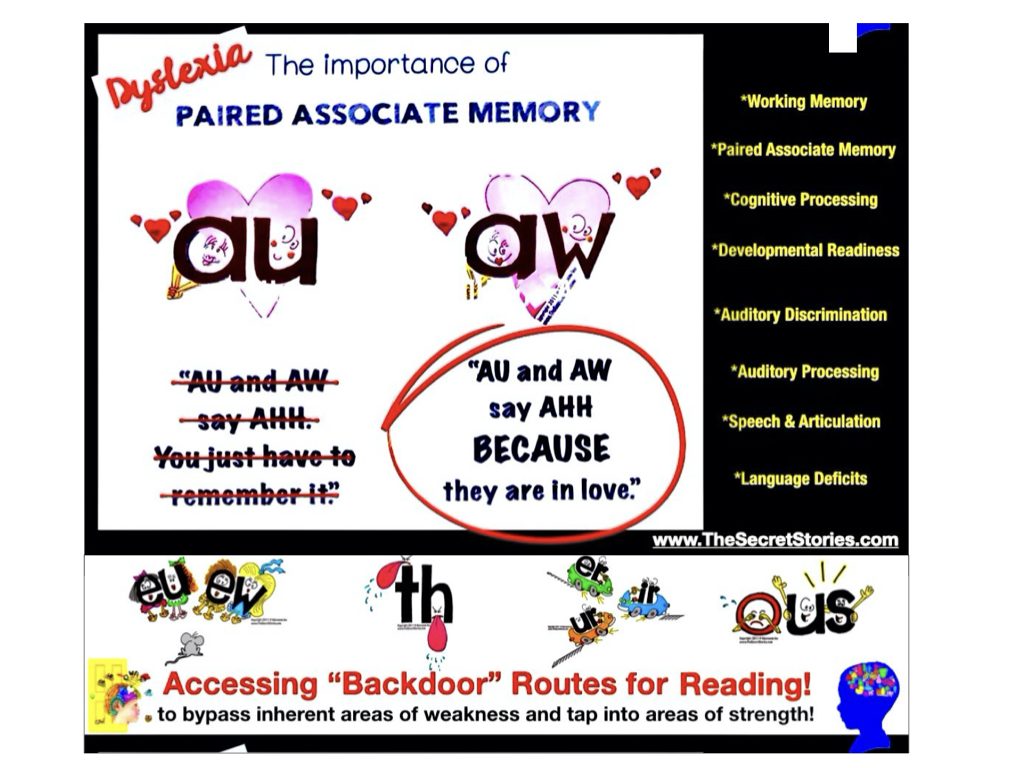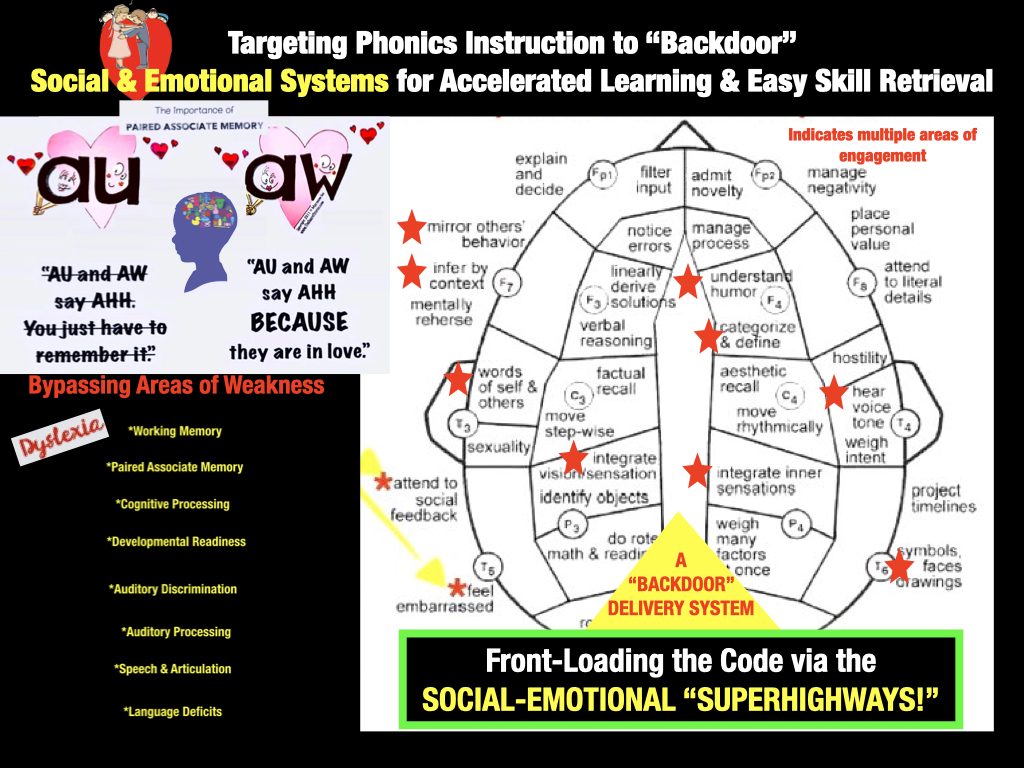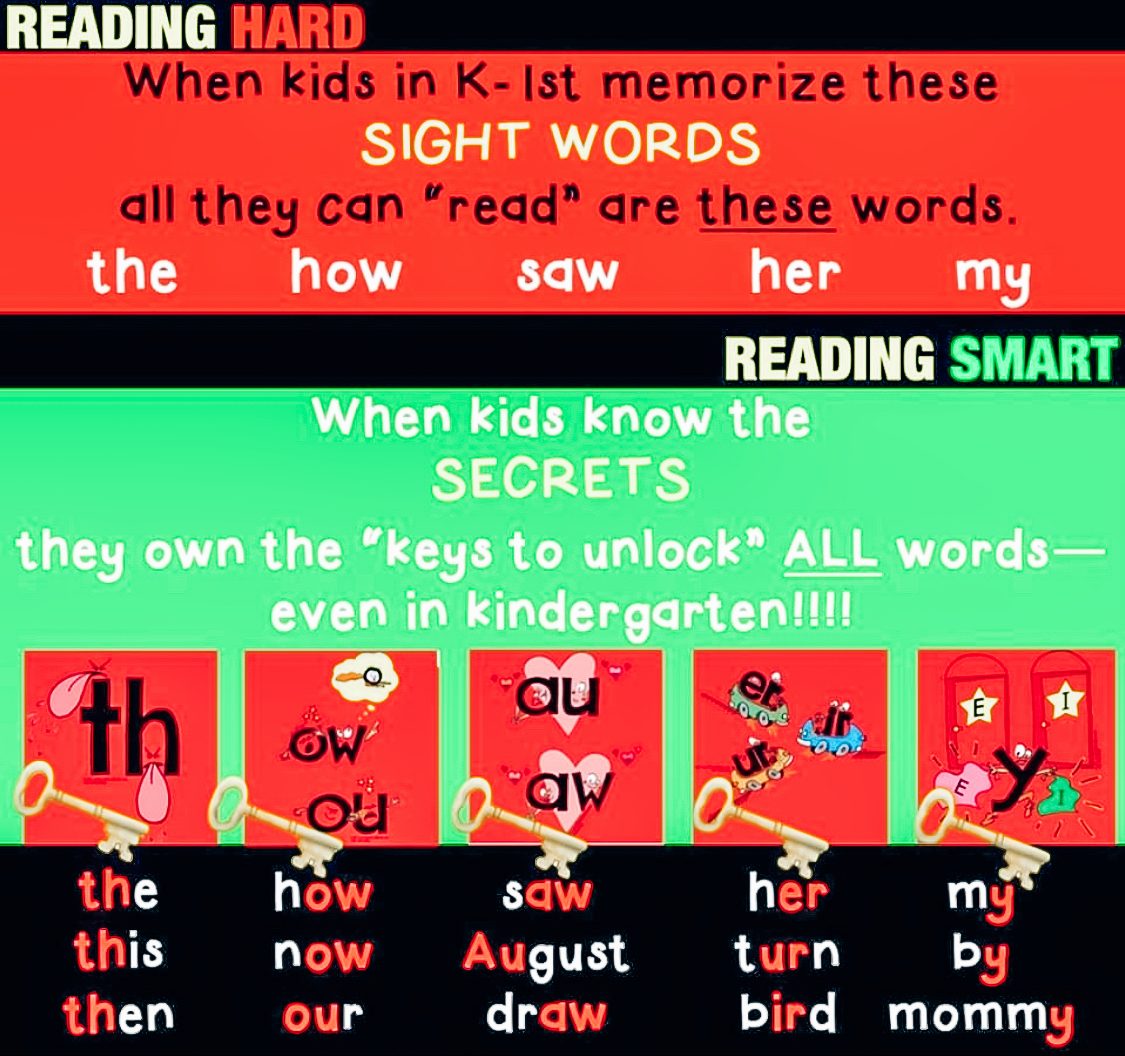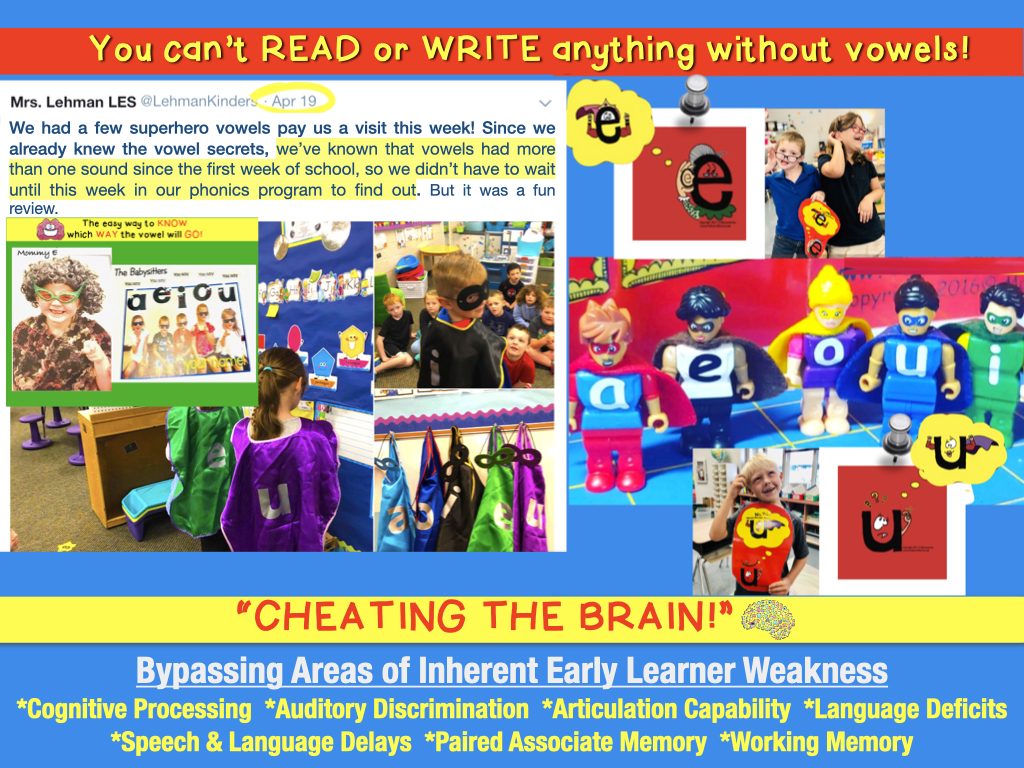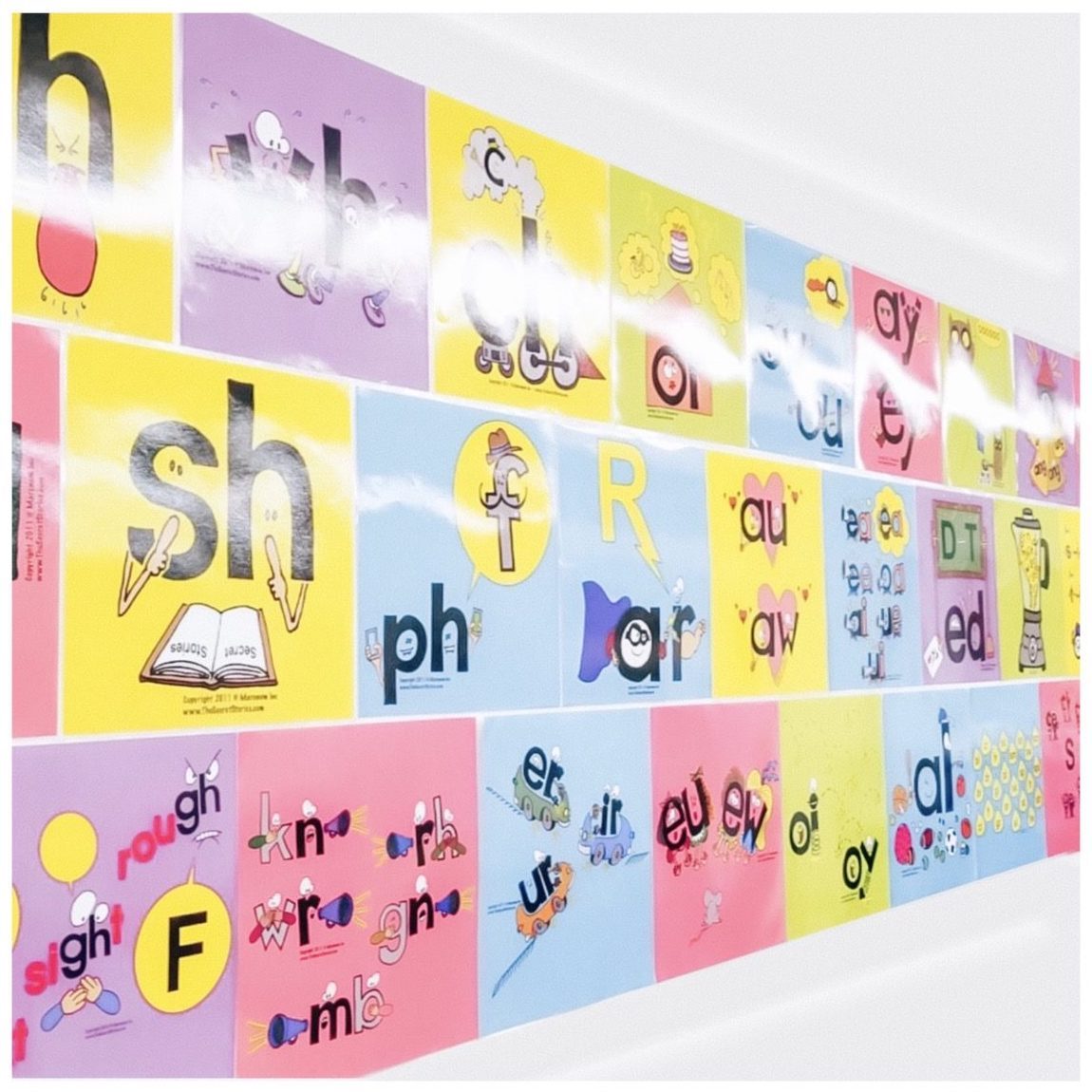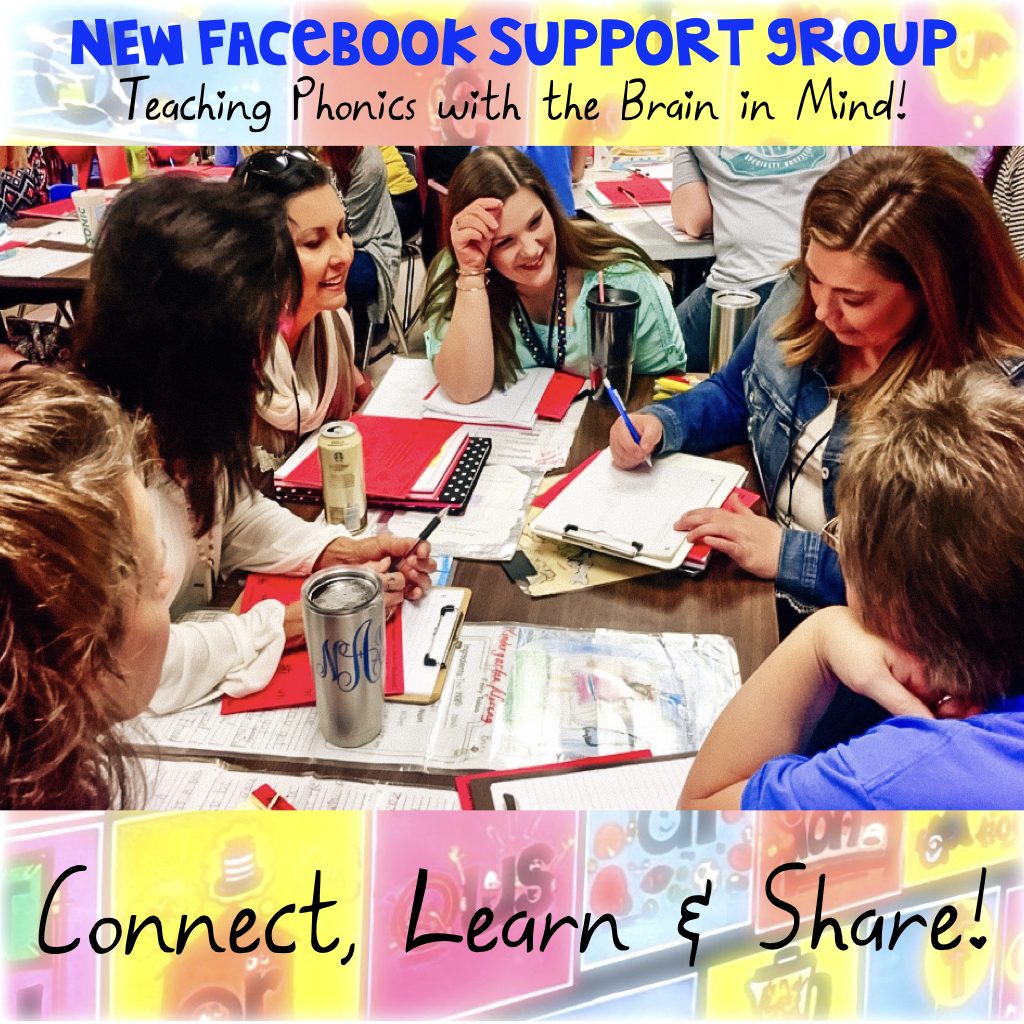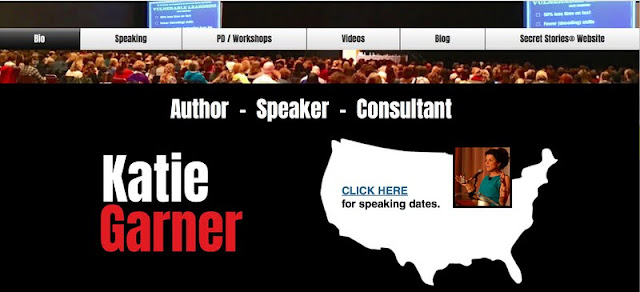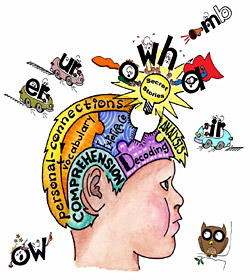A Guest Post By Melissa Gregory
—Kindergarten Teacher at Title I School in Ohio
Kindergarten- End of October
Who says kindergartners can’t have access to ALL of the code needed to read and write in a short amount of time????
By the end of the FIRST NINE WEEKS, these cuties are taking off in reading AND writing, and are so excited to be word detectives finding ‘secrets’ in every word they see!!!
Kindergarten Writing in Mid-November
My Journey from First Grade to Kindergarten
My name is Melissa Gregory, and I am a kindergarten teacher at a Title I School near Cincinnati, Ohio. This year was my first year teaching kindergarten, though I’d taught first grade for many years. I sent Katie the video of my class in late October, as I wanted her to see how fast my kindergartners were soaking-up all of the Secrets! These little kindergartners knew ALL of the them by the end of October, even though they were still learning their individual letter sounds with the Better Alphabet Song.
Having only taught first grade before, I had no preconceived notions about what kindergartners were “supposed” to do, and so we just “played” with the Secrets all the time. The Secrets were not only their favorite stories, but also their favorite “toys.” They didn’t just “know” them, they were actively using them to read and spell words! With every day came new growth and discovery, and being new to kindergarten, I felt like I was learning right along with them. I was just so excited that I had to share it, and from the moment that Katie posted our little video back in October on Facebook, we both began receiving so many comments and questions. Most wanted to know if the Secrets they knew in the video actually transferred to their reading and writing, and if so, how? So, Katie asked me to track of all of this year’s data and write this post.
This comment, in particular, sums up what many who saw the video back in October were curious to learn—
Hi Melissa,
I am not understanding how this transfers into their reading & writing since it is done in isolation. Is there any assessment data showing how well kids can actually read? I show my students many videos and we sing many songs too, but I don’t see all kids accessing the information later in their reading and writing.
Thanks for any insight you can provide!
My background in first grade….
Having taught first grade in a large school district for the past ten years, this past year was to be my first ever teaching kindergarten. Our district had expanded from four Early Childhood Schools to six, and I was moved to a new building and placed in kindergarten. My new school was a Title 1 and Title 3 school, with both ESL and free and reduced lunch population.
I had been using Secret Stories in first grade for the past seven years, alongside the Lucy Caulkins Reading and Writing Workshop Model, which our district had adopted several years back. Secret Stories was a game-changer for me, as it gave my first graders more of the phonics “code” they needed to actually do reading and writing workshop! As a result, my students had always shown unbelievable growth—not just in their reading, but in their writing, as well. Knowing the Secrets gave them confidence to tackle new words in reading, write more complicated words in their stories, and even figure-out unknown words in their story problems for math.
As early grade teachers, our students are just learning how to “do” school, and so testing is not what is most important, nor should it define them. However, data is extremely important to principals, as well as to district and state-level administrators, as it provides a “snap-shot” of current student performance. If you were to look at my data from seven years ago and compare it to my data now, you would see a huge difference. Yes, I am sure that I have become a better teacher over time, but the truth is, I didn’t have my secret weapon, and so I couldn’t give it to my students. That’s what the Secret Stories are to me and my students. They are our secret reading weapon, and they continue to be the BEST gift I could ever give my kids!
Before I discovered Secret Stories, I had to do weekly word practice and a phonics focus, and so my calendar looked like this…
Sight Words, Word Families, and Phonics Rules (a.k.a. “Before Secrets”)
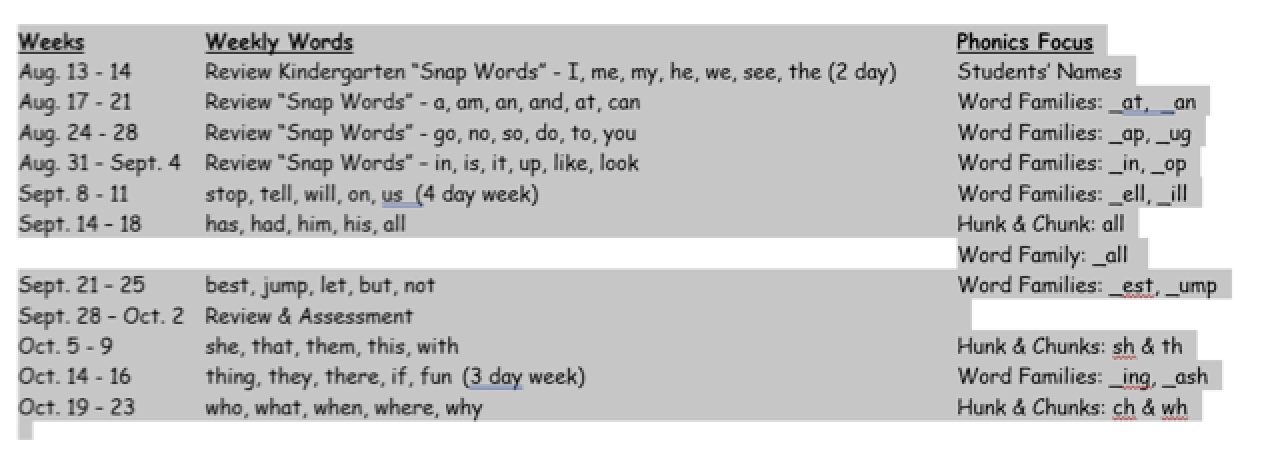
Everything was taught in isolation and nothing was authentic….or fun. Students would learn the sight words, word families and phonics rules for the week, and then we would move on with hope that they could retain those words and rules. There was no spiral-teaching, except for the weeks we reviewed, and those were only for the sight words, not the word families or phonics rules. I look back now and wonder how my class ever reached the levels required by the end of each school year? During the week, I would use rainbow word worksheets, word sorts, letter tiles and magnetic letters to practice the sight words, and I had a block of time set aside for word study each day.
Becoming Secret Word Detectives
The first thing that you notice when you start telling Secrets is how they naturally integrate with everything that you are already doing. They are literally everywhere! I no longer needed to set aside time for word practice or phonics “kill and drill,” as the kids were naturally using them ALL DAY LONG—in reading, in math, at lunch, in art…..anywhere and everywhere there were words, they found Secrets! Skill-reinforcement was “baked-in” to everything that we were already doing—across all subject areas, as the kids were constantly using them to read and write words. They loved being word detectives and spotting Secrets wherever they were hiding! My teaching became more authentic, which made learning easier and more natural for my students.
From day one, I had all of the Secret Stories posters hung in my room, and I started showing my kids how to use them. I explained that the Secrets were the “keys” they needed to “unlock” words, and I modeled using them for this purpose constantly. Whenever we came to a word that they couldn’t read or spell, I told them the Secret, and then showed them the poster and reminded them how they could use it to read and spell other words on their own. And off they went! During free choice time, they pretended to be the teacher, using the pointers to show and tell the Secret Stories, and then calling on their friends to make the sounds and show the motions. They referred to the posters constantly, sometimes to actually read or spell a word, and sometimes, just to “play” with telling their story and making their sound. I actually have the posters hung on both sides of my classroom so they can easily see them from anywhere, which just goes to show how much the kids use them!
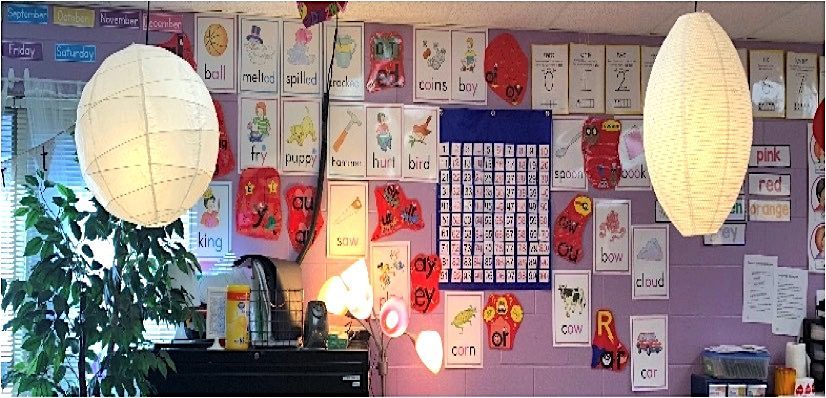
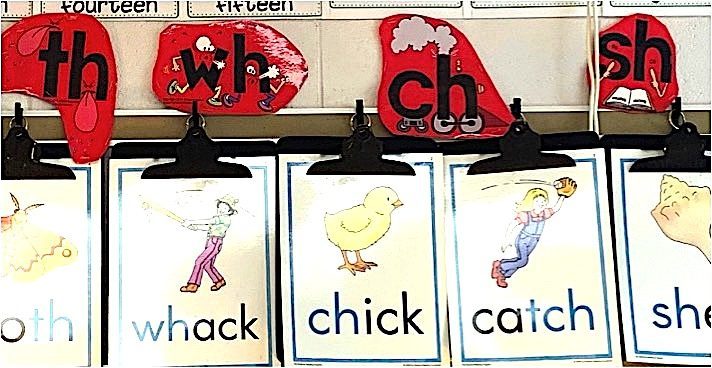
Letters Behave Like Kids
The day I told them the first Secret Story, my teaching changed forever. Having a way to make phonics make sense just made everything we were already doing so much easier! Five and six-year-olds may not understand (or care about) letter sounds, but they do understand that letters behave differently when they are together with different friends, just like they behaved differently with different friends. In the Secret Stories, kids saw their own feelings and behaviors reflected back, which is why they loved hearing and telling them so much. The Secrets come from a place that kids can easily identify with and understand, like, for example: how a line leader is supposed to behave, when to (and when not to) be sneaky, not getting along with your classmate, being left out of a group, having to listen to your mom (or your babysitter!), and even what it would be like to have super powers! The Secrets make kids wonder. They made them curious. They make them think. But most of all, the Secrets make them want to know more Secrets!
Teaching Kindergarten…
My first graders had always learned the Secrets quickly, which is what made our Reading and Writing Workshop take off, but when I moved to kindergarten, I wasn’t sure how this would go. At curriculum night, I shared with parents that I was unsure about how kindergartners would do with Secret Stories, since I’d only used them in first grade. But I also told them that if their kids were going to be reading and writing in kindergarten, then they were going to need them!
Our end-of-year standard for kindergarten was mastery of: individual letter sounds, 25 sight words, and three digraphs- /sh/, /th/ and /wh/….and that was it. My first grade teacher-brain couldn’t help but wonder what in the world kids were actually supposed to be able to do with that?! However, I knew that, as a kindergarten teacher, I would be spending a lot of time on individual letters and sounds, and would need to focus on those first. I was even concerned that giving them the Secrets might be too much…..oh boy was I wrong!
Word Work Playground
The Daily Calendar
At the early grade levels, the entire day is a playground of word exploration and play! I actually shared the first Secret before I’d even introduced any of the individual letters and sounds. It was the Secret about au/aw, which I told them on the first day of school during calendar time. (I remembered seeing Katie doing this in a kindergarten YouTube video and so I thought I would do the same.) I asked the kids how many of them knew what a “secret” was. I told them that there were special secrets that could only be told to very special kindergartners, and that these secrets would help them to become better readers and writers. I also made sure to let them know that they could tell their parents (or loved ones), and that when they go home, they could pretend to be the teacher and teach the Secret Story to them.
School starts in early August, and we do Calendar Time every day, so since we would be “reading” the word August on a daily basis, it made sense to explain why the /A/ wasn’t making the sound it was supposed to (based on the sounds it makes in the Better Alphabet Song, which we also sang every morning and afternoon). To understand why, the kids would need to know the Secret about au/aw.
The picture below is not of me or my class, but I found it on one of Katie’s blogs, and it gives you the idea.
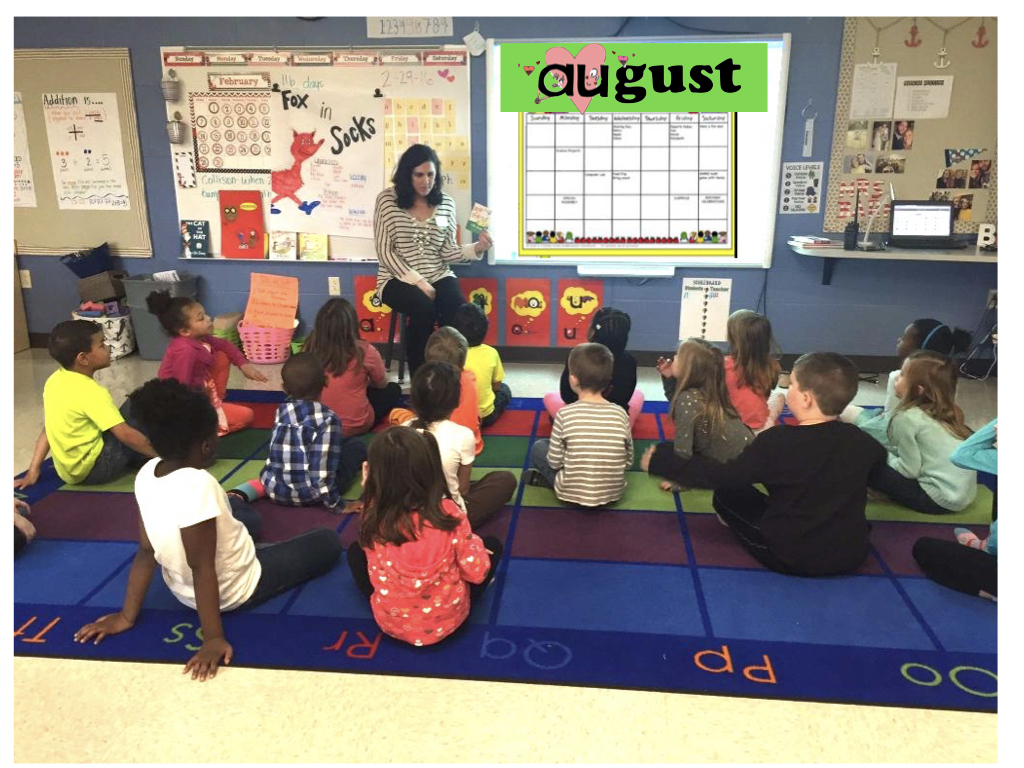
Whenever I told them a Secret, I would make a huge deal about how they were ‘grown-up’ reading and writing secrets, and that no other kids were allowed to know them! Then throughout the rest of the day, I would introduce other Secrets, as we needed them to read and spell words that we would frequently use or encounter (i.e. student names, high-frequency sight words, color words, math words, etc…). Then we could use these Secrets to crack even more words that we came across. Once you begin telling Secrets, there is a sort of “snowball-effect,” which quickly takes on a life of its own, as the kids start to drive their own learning!
Over the next two weeks, I had introduced them all authentically. I purposefully searched for ways to introduce them to the class that would be meaningful.
Student Names
I introduced Secrets to help us read and write the names of students in our class. Kids love to talk about, explore and “play” with their own names, as well as their friends’ names. They especially loved keeping track of whose names had which Secrets in them, often alerting visitors to our class that they had a Secret in their name, but then refusing to tell them what it was….because of course, it’s a “secret!”
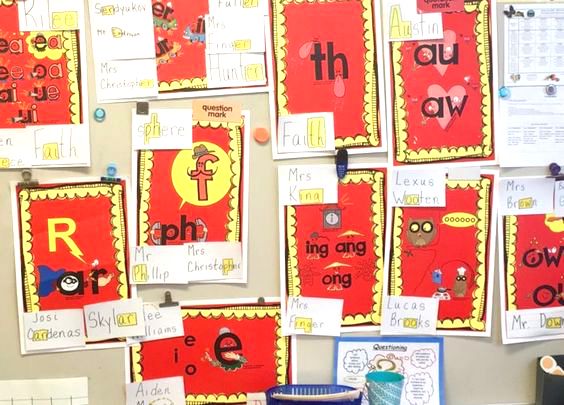
Read-Alouds
I introduced Secrets that we found in our read-aloud mini-lessons. And while I don’t have a picture of this from my own classroom, I did find this video of Katie doing the same.
Word Study in Math
When talking about Math Workshop, I introduced the Secrets that we needed to read those words (/th/ and /sh/). I really wanted the kids to see the Secrets as their own, personal keys to unlock any word—not something that was confined to our reading lesson. The video below demonstrates this point.
Environmental Print
As we practiced walking around our building, trying to learn where places were located, I would point out the Secrets in words that we saw on the walls. I asked parents to send in environmental print, and we would use the words they brought in each day to teach more Secrets. For example, to read the store name, Target, we learned the Secret about /ar/. 
When we saw the word Walmart, we needed the /al/ Secret to crack it, along with the previously learned Secret about /ar/. Learning was authentic and continually spiraling. Secrets were shared and re-shared, with the kids never tiring of re-telling old Secrets and learning new ones. And all this was happing simultaneously to picking up the individual letters and sounds with muscle memory, via our Better Alphabet Song (sung twice a day, every day!) I actually caught one of my little guys, who was obsessed with this song, singing it to himself at recess, and I recorded it, as he was just so cute! It’s the video below.
Now I’ll admit that teaching all of the Secrets in the first two weeks of kindergarten isn’t what Katie says to do in her book, but my kids were so hungry to hear more Secrets, that I thought, why not? After all, they’re just stories….and who worries about telling kids too many stories??
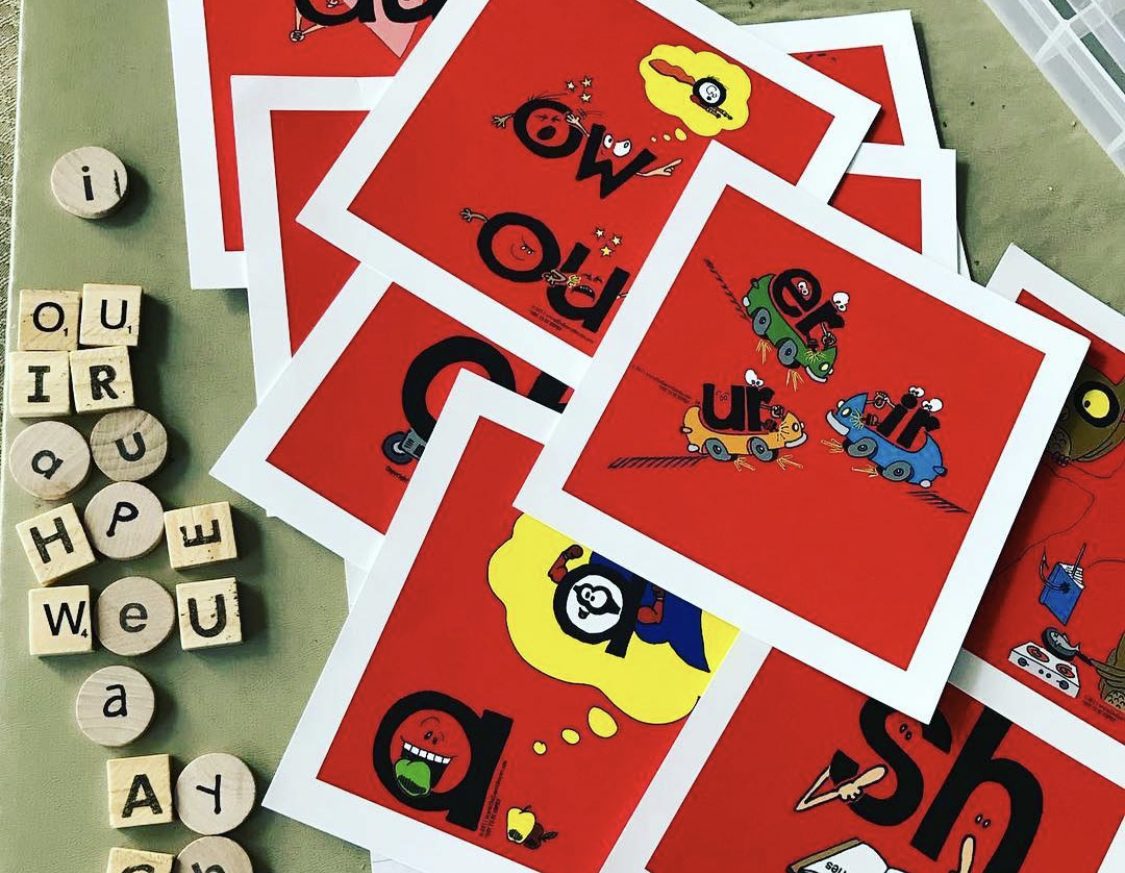
I know what you’re thinking (especially if you teach kindergarten), but before you judge, just remember that I wasn’t “teaching” skills, I was telling stories! Stories that they loved and would beg to hear! Also, having never taught kindergarten before, I had no preconceived notions about what kindergartners could and couldn’t do. All I knew was that they kept begging me to tell them just “one more Secret”….and so I did! And every one that I told came back to me like a boomerang in our daily reading and writing—which would only motivate me to tell more! (I literally could not keep a secret- Lol!)
The more Secrets I told them, the more they wanted. The more Secrets they had, the more words they could read and write. Secret skill transfer to reading and writing was easy and natural, as it is only for these purposes that Secrets were shared, so kids automatically made this connection, unlike with an isolated phonics skill lesson. And unlike a phonics “program,” Secrets aren’t grade-specific, and there are no scripted lessons to follow, making it easy to work them into everything you do—any time, any where, and for any purpose….without any prep!
Non-Conscious Learning
One of the first things that I discovered in kindergarten was that five-year-olds were just as excited to hear the Secrets as I was to tell them! The more excitement I showed, the more they showed, and the more they were learning without even knowing! Without any prompting, they were finding Secrets everywhere, and then telling each other their “secret” sounds. I was constantly amazed at how their little eyes lit up every time they spotted Secrets that they knew in words—from reading passages, to the cafeteria menu, to signs in the hallway. I was even told by parents that “Secret-spottings” were happening at home on newspapers, magazine covers, and even on signs! These little kindergartners were quickly realizing that everywhere there were words, there were Secrets, and that they had the keys to unlock them.

My “original” Secret Stories book….well-loved and well-used! Kids loved to play with it at centers.
On the 100th day of school, I asked my kids to write about their favorite part of kindergarten, and almost all them said it was learning Secret Stories! These kids were on fire, absorbing and learning everything they could about this ‘grown-up’ world of reading and writing! All day long, they were pointing them out, and I would tell them that we were “stamping our brains” with new Secrets each time we found them in text.
If my kindergarten journey this year has taught me anything, it’s that the most powerful learning occurs when we don’t even realize it’s happening—when learning and fun become one! From the moment that I told the first Secret, my kindergartners were hooked, just like my first graders were.
If we were reading poems, they wanted to circle the Secrets. In read-aloud, they wanted to come up and put highlighter tape on the Secrets. Even in math, science and social studies, they were always “on the hunt” for Secrets. They were obsessed, and it was wonderful! It was so much fun watching their excited conversations about what the Superhero Vowels® were doing, and whether they would “say their name” or be “short and lazy” (if Mommy E® or the Babysitter Vowels® weren’t around). Both their reading AND writing just soared!
To see just how obsessed they were with the Secrets, check out this video that was sent to me by one of my parents of their child’s birthday party. In the caption, the father wrote, “The secrets really ARE everywhere!”
Secret Stories to Sound Out Words for Reading
When my students are reading and come upon an unknown word, I don’t tell them what it is. Instead, I tell them to look for the Secrets.
Several years ago, when I started teaching first grade and hadn’t yet discovered Secret Stories, my kids were usually unsuccessful when attempting to sound out most words, unless they were simple C-V-C words, like cat, bed, cut, etc… Now that my kids know the Secrets, they wouldn’t even start sounding out a word without first noticing the Secrets that are in it. For example, before they knew the Secrets, my first graders might try to sound out the word first like this, “ff-ih-ruh-ss-tuh,” making each letter sound individually. With the Secrets, even my kindergartners will automatically say, “f-ir-st,” because they immediately notice the Secrets and blends.
This is another reason why it is so important that all of the Secret Stories posters are up on your wall where kids can easily see them, as it’s the first place they’ll look when they can’t read or spell a word. It’s also important to encourage them to use the motions or action that naturally goes along with each story sound. Unlike a “program” (i.e. Zoo Phonics, Letterland, Jolly Phonics, etc…) the Secret Stories motions aren’t arbitrary actions that you have to know and remember, but just the natural physical response of engaging in the action/making the sound, like holding the steering wheel and slamming on the pretend brakes when saying, “Errrrrrrrrr” (for er/ir/ur) or sticking your tongue out and making a mean face when saying “thhhhhhhhhh” (for /th/).
We don’t just “stamp our brains” with the pictures, but with the sounds and actions as well! All children learn differently, and the more modalities we can incorporate in our learning, the more connections we make in our brains! Secret Stories’ multi-sensory instruction activates all of the senses—see it, say it, do it and even FEEL it— for deep learning, which is why the Secrets “stick” so easily, even for kindergartners. The visual below is actually from Katie’s session handout, but I wanted to add it here to show how a multi-sensory approach to instruction (especially for phonics) helps to forge deeper learning connections in the brain.
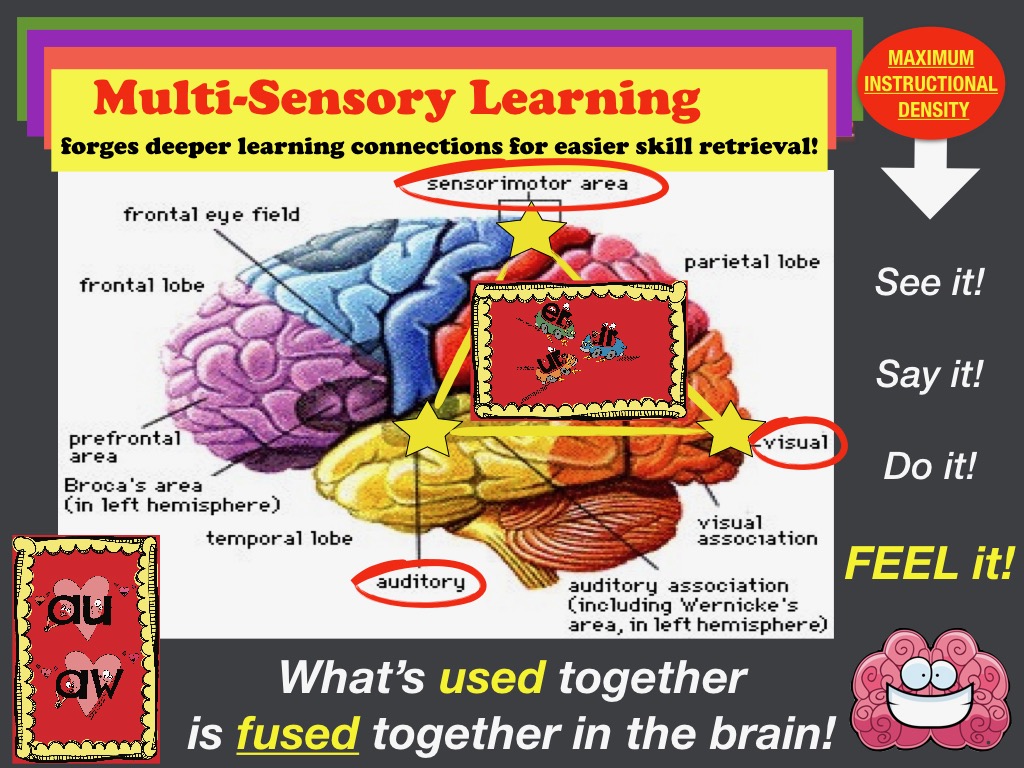
Kindergarten in December
The following videos are of students in my class, who you will see looking up at the wall behind them to find the Secrets they need to decode the words they’re trying to read. I always give them a little time before asking what Secret (or Secrets) they see. These clips are from early December, back when they were still learning how to actively decode new words. As their decoding ability improved, we were able to focus more on fluency, which you will see in later videos further down below.
*Note that these are “cold” readings of instructional-level text, which means that it offers some challenges, based on their current reading level, which of course, is different for each child. Most often, in guided reading, I intentionally select more challenging text (rather than easier books) so as to give them words that they might struggle with a bit, so as to help them stretch and grow as readers.
“alarm”
“fire”
“wait”
“made”
Teaching the Reader, Not the Reading
The Secret Stories reach every child. My ESL students and little ones on IEPs were able to pick them up just as easily as the rest of my kids. No matter how a child learns, the Secrets just make sense. Kids who aren’t yet developmentally ready to read still love to hear and tell the stories—talking about them like they would their favorite TV or video game characters. But for kids who are ready, these simple stories open up a whole new world of reading and writing for them to explore! Because the Secrets apply to everything we do in kindergarten, reinforcing them is easy and can be done with high, medium and low-level learners, simultaneously. While higher-level learners are able to transfer knowledge of the story to the sounds and letter patterns they need for reading and writing, lower-level learners are simply enjoying knowing and telling the story, not yet realizing the power that it holds.
The first time that I did a Running Record on a child in kindergarten after having introduced all the Secret Stories, I was in shock! Our reading was off the charts, and so were our scores. Once my kindergartners had successfully gotten me to spill all of the Secrets (yes, I blame them!) they were unstoppable. The best part of teaching kindergarten was watching the extreme progression from kids knowing little-to-no letter sounds to becoming full-fledged readers! The transformation was incredible. The second best part was seeing their excitement as they evolved as readers and writers. I only wish that I would have recorded this child at the beginning of the year when he still didn’t know all of his letters or sounds!
Kindergarten Reading Level – Late Fall
Kindergarten Reading Level – Winter
It was around this time in mid-December, just before the holiday break, that I sent Katie the following update….
I just completed our F&P (Fountas & Pinnell) assessments yesterday and today on my kindergarten class! Our kids have to be at a level D by the END of the year, and more than half of my kids are already there, with 10 reading between levels F-I! And most didn’t even know their letters and sounds at the beginning of the year!
Not having ever taught kindergarten before, I am just floored by their progress! I was in first grade for the past 11 years, so I was not sure how quickly kindergartners would learn the sounds and put it together in order to read fluently. Well, by December, they were reading and comprehending!!!!♥️If anyone ever wonders if the Secrets work in Kindergarten, they should hear these angels read and comprehend. I myself am amazed! Sorry, but had to brag about Secret Stories! I know all of the teachers out there who use it will get it! 🙂
PS We also do Maps Testing, and I can’t wait to see the difference in overall growth from September to December! I will share that when I get it.
—Melissa
Below is my kindergarten F&P data showing where we were in December, as well as their overall growth by the end of the school year.
“Fountas & Pinnell” Reading Level Assessments
Note that by the end of the school year, 50% were reading at “end of first grade” level, having passed level J (the highest level-assessment allowed for kindergarten by the district). This is compared to 6% of kindergartners, district-wide (including students from non-Title I schools).
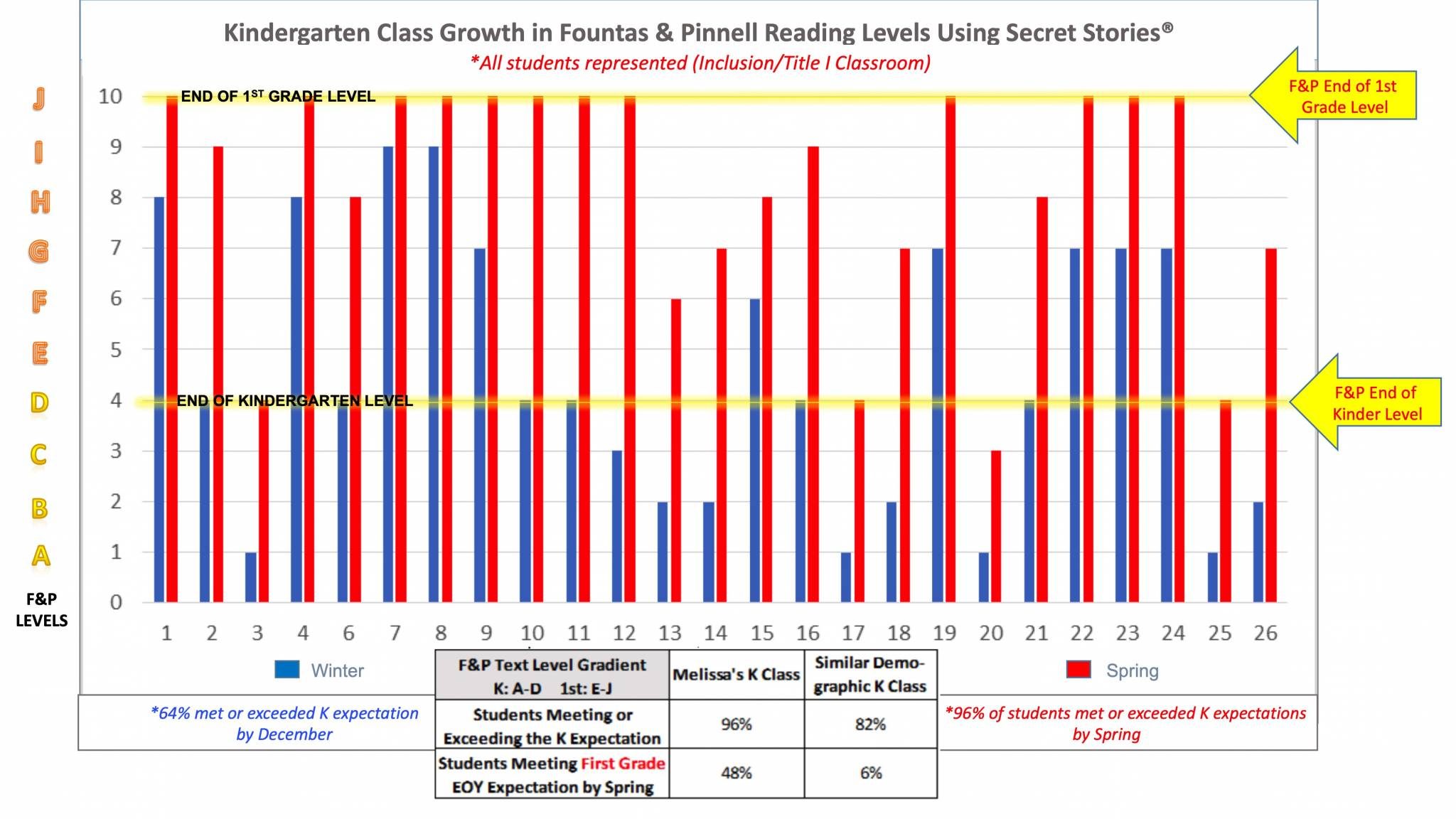
Our district also uses MAP Testing with a projected RIT score to show where kids should be by the end of the year. Those who use NWEA MAP will better understand the data below. For those who don’t, the projected RIT score is for Spring. As you can imagine, several students had already surpassed the projected RIT score by Winter testing. Our administration looks at the percent of projected growth met, which should be around 100% by the end of the year. Anything above that indicates how much more a student grew than was expected from their RIT score.
On average, there should be about a 10-point growth from Fall to Spring. The assessment data below shows growth from both winter and spring. Keep in mind that these assessments are just a snapshot of the entire child, and do not inform what is good overall growth. They are most useful to ensure that all students are continuing to move—from the lowest to the highest. Average student growth on this assessment is traditionally between 80%-120% percent. My average student this year in kindergarten was over 200%.
Kindergarten “Map” Testing – Reading
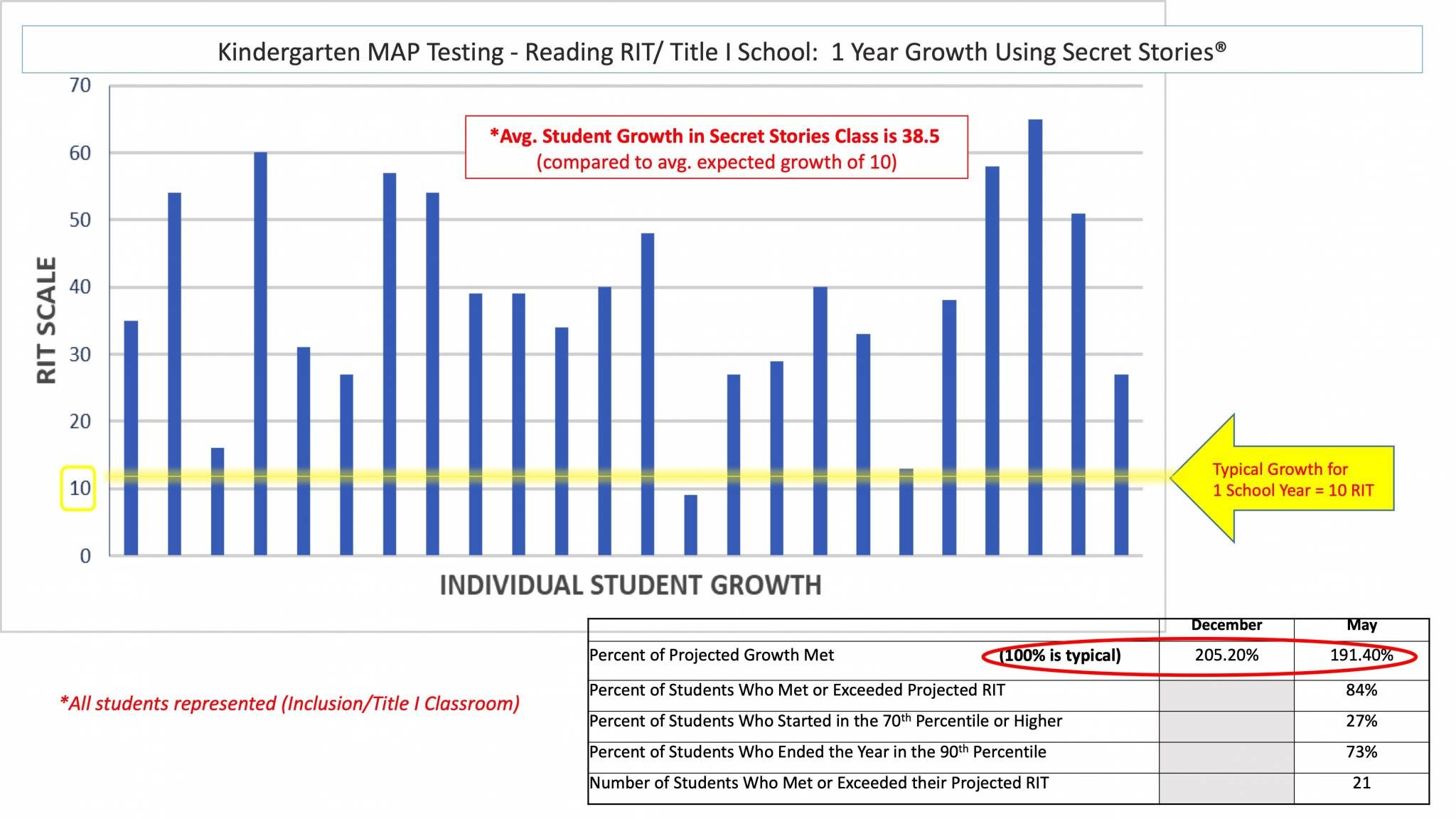
As I stated above, while data is important, it provides only a snapshot of the whole child, especially in kindergarten. Secret Stories have improved my scores immensely over the years, so I no longer worry about testing, as we are always way ahead of where we need to be, midway through the year. Not having to worry about teaching the “reading” means that I can focus more on teaching the reader. That’s where I can invest my time and energy, not on sight word lists and reading “practice!”
Word Work Activities and Phonics Play
Midway through kindergarten, my class had become highly-skilled word detectives, and our “word work” was never limited to our reading block! We circled and highlighted Secrets in the stories and poems we read, put highlighting tape on our big books, and were always on the look-out for Secrets hiding both in and outside of our classroom! Reading and writing was never limited to an isolated “phonics” or “word work” time; it was immersed into every part of our day! Whenever Secret phonics patterns were spotted, we would circle or highlight them. Then we tap out the word, chunking each Secret Story sound together (instead of saying the letters sounds individually). For example, if we came across the word thirds in Math, we would highlight the letters /th/ and /ir/, and then tap and sound it out as, it out as “th-ir-d-s” (as opposed to “t-h-i-r-d-s”). We would even use a large magnifying glass to show how the Secret letter patterns should jump out at you before you start reading them!
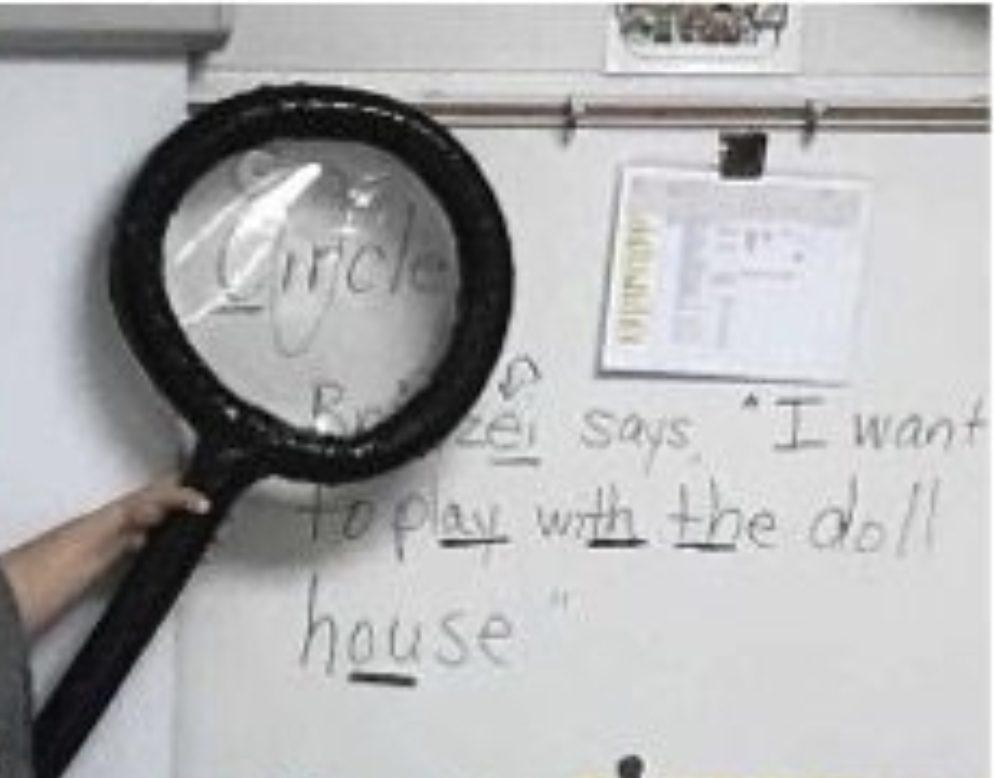
Using a document camera, we would look at poems, like the one about leprechauns, below. We would then circle all of the Secrets we could find and read it aloud, together. If you walked into my room, you would see that no matter what paper I put in front of them, they would all find and circle the Secrets before I even mentioned looking for them.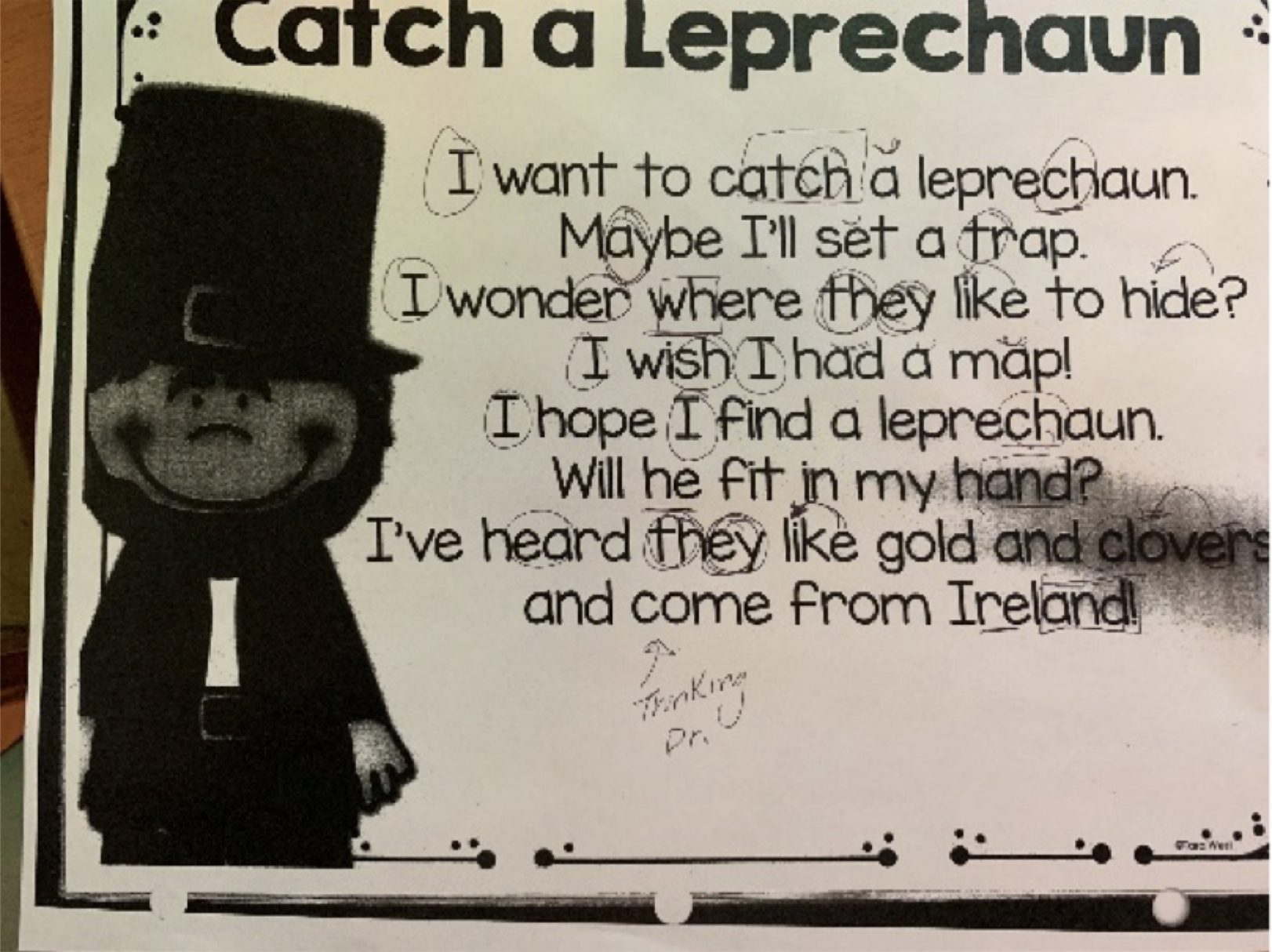
Secret Stories Hunts
Another fun opportunity for phonics play is going on Secret Story “Hunts,” as this is a great way to strengthen beginning learners’ visual acuity to quickly recognize letter patterns in text. While we often do this at guided reading with our little books, we also like to “hunt” for Secrets in words all around our classroom. We can hunt for words that contain a specific Secret Story pattern, or for words with any Secret Stories patterns! We can also use a timer to make it into a contest to see who can find the most—although to win, they have to be able to READ all of the words that they “captured!” Another fun twist is to extend the hunt to the hallway, the cafeteria, the principal’s office, or even the entire school! The picture below shows the kids going on a Secret Stories Hunt around our classroom.
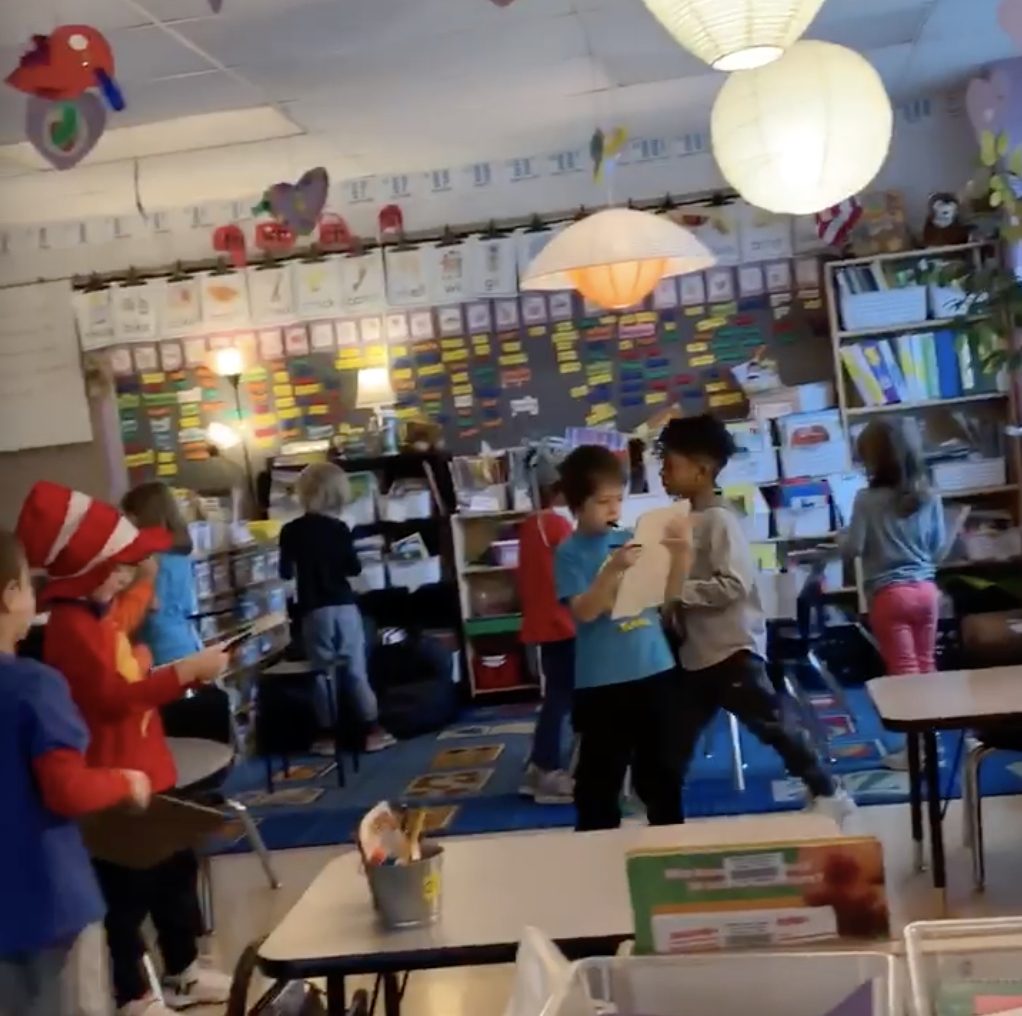
“Sentence of the Day” and Focus Words
We also have a “Sentence of the Day” book, which we make and do together every day. The students start at the carpet with me, and I introduce the sentence and our focus word.
For example, in the video below, the sentence was, “She is not in school today?” with the focus word, not. At the beginning of the year, I would have to read the sentence to them a few times, but at this point, they are doing a cold read of the sentences to me. We literally take apart the sentence. The students look for Secret Stories, punctuation, capitalization, plus anything else they happen to notice, and then we pull out one word, and think of more words that rhyme with it.
This is a great way to reinforce awareness that if they know how to read and spell the word not, then they can also read and spell the words lot, hot, rot, shot, etc… or, as in the next clip below, if they know how to read and spell the word will, they can also read and spell words like: hill, pill, fill, chill, etc… This activity is a powerful one, as it reinforces everything they know about reading and writing, and provides an easy to way to informally assess their ability to apply the Secrets. It’s also a great way to increase phonemic awareness, as well as recognition of word families for both reading and spelling, but without causing confusion between simple word letter patterns (like -op, -at, -it, etc…) with Secrets (which are the sounds letters make when they don’t do what they should!)
Once we have finished, we then read the sentences three or four times (or more at the beginning of the year). Then the kids go back to their seats, write the word four times, and then write the sentence in their very best handwriting. When finished, students will raise their hands and read it to me. When first starting to read, I have them point to each word as they are reading it so that they can practice one-to-one correspondence, which some students continue doing through the year.
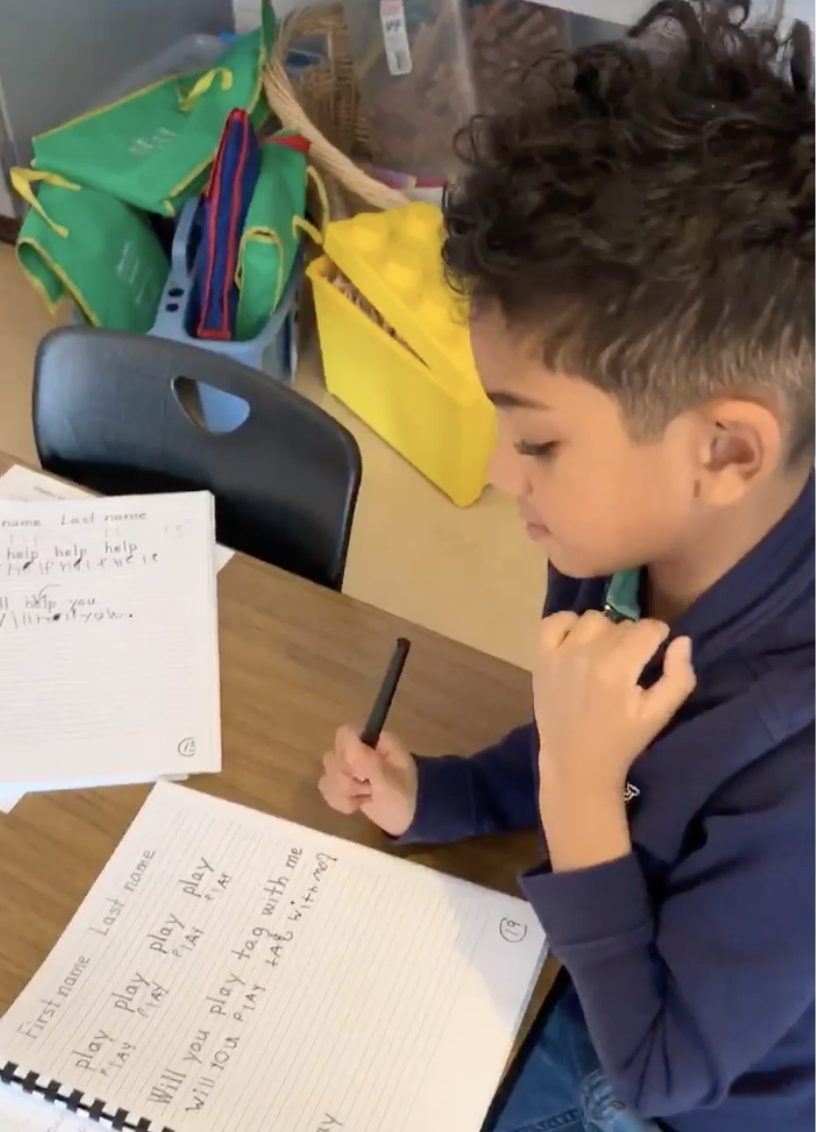
Merry-Go-Round Phonics Instruction
I can’t stress enough the importance of activating all of the modalities in learning practice—the visual, the auditory and the kinesthetic. Whenever we would spot Secrets, we would always reference the poster (visual) while making the sound (auditory) and doing the motion (kinesthetic). By presenting information to the brain from as many angles as possible, Secret Stories fosters deep connections that learners can’t forget. Katie talks about how Secret Stories offers kids a “merry-go-round” for learning that just keeps spinning, giving kids who need it more time “jump on,” and giving them never-ending opportunities to do so. We keep our merry-go-round spinning by always taking the time to re-tell the story, reference to the poster, and engage in the action with the sound. This constant reinforcement of what the Secret is, where it lives (on the wall), and the sound (or sounds) it makes helps to ensure that our merry-go-round never leaves anyone behind—regardless of where they are in the learning process.
Reading “Hop-Scotch”
Whenever we stand in line before leaving the classroom, one student gets to take my pointer and be the teacher, pointing to the different Secret Stories posters (or words on other posters) hanging in the room. Whatever words were pointed to, the kids would have to read as quickly as they could. This simple game actually had a big impact on their learning, and was well worth the extra five minutes it took to line up. It was during these short, little 3-5 minute windows that I first began to see them evolving into readers before my eyes! Their writing was also improving with each passing day, as they got better and better at using the the posters to transcribe the sounds they heard into readable words.
Using Secret Stories with the Reading and Writing Workshop Model
Our district has used Lucy Calkins’ Reading and Writing Workshop Model for the past 15 years. Before the Secrets, I would follow the Readers/Writers Workshop books like they were my Bible!
I was teaching first grade when I first heard about the Secret Stories from my sister, who was also a first grade teacher, as her school had just purchased them. She would rave and rave about them, telling me all about her school’s success. I was intrigued, but as with any new “program,” I was a little apprehensive. The last thing I needed was something else to teach, and I didn’t really want another book with more lessons that I would have to squeeze into my already overstuffed day. But once she explained how easy it was, and that it really wasn’t a “program” at all, I was all in!
I decided to purchase it with my own money and immediately begin introducing it to my first grade class. Some of my first graders at the time were already reading, while others were still working on letter sounds and sight words, though all of them were captivated by these little “secret” stories. A wave of learning began to rise across the different levels in my classroom, with everyone taking something away from each Secret that I told.
I could write a big word on the board, like for example, vacation or assumption, and while my stronger readers would use the Secrets to silently sound out the word, my lower-level readers would be equally excited to just look for the Secrets and tell their stories while acting out their sounds. Despite the different levels, we could all go back and blend the letter sounds and Secrets together to read the word aloud. To me, this is the epitome of what Katie refers to as, “Buffet-Style” Instruction, with all level learners able to come to the table and “eat” what they’re ready for! The result was a no-prep “multi-tiered” word work activity that not only reinforced the Secrets, but also that no matter our age or grade level, if we knew the Secrets, we could figure out 99% of the words we encounter! (And if you’re wondering how this would work with words that don’t follow phonics rules, that’s actually the most fun part….getting to be “Word Doctors,” which you can read more about here.)
Phonics Units of Study /Phonics Workshop Model
This school year, our district adopted the new Lucy Calkins TCRWP Phonics Units of Study/Phonics Workshop for kindergarten and first grade. This was another thing that I was concerned about when moving to Kindergarten, as I was unsure how to incorporate Secret Stories with a phonics program.
We didn’t receive our TCRWP Phonics Units Teacher Kits until October, so during a professional development on how to use them, we were told to begin on book 2. given that book 1 was geared toward the very first few weeks of kindergarten and we were now two months in. Once I got started, I quickly realized that my students already knew all the concepts—not only book 2, but in book 3, as well. So I had to jump ahead to book 4, and even then, I was able to skip several more lessons that my kids were already able to do.
The reason I was able to skip so many books was not just because we’d already learned all of the skills presented, but because we had been using them daily in everything we do. And while this might seem as though it would present a conflict, it’s actually quite the opposite! Because we didn’t need to engage in any of the phonics skill introduction or practice work in the program, we were able to take full advantage of the open-ended, extension activities for authentic reading and writing that the program offered. The Phonics Units turned out to be a perfect “playground” on which we could flex our Secret Stories “muscles” in a variety of ways for reading and writing!
In the Phonics Units of Study, Lucy Caulkins stresses that in order for beginning learners to be able to transfer phonics skills to reading and writing, they need faster access to them. But unlike the Phonics Units, which deliver phonics skills by grade level across kindergarten, first and second, Secret Stories fast-tracks the WHOLE code in kindergarten by giving kids a way to understand letter sound behavior—so they don’t need to memorize everything, or learn through rote practice. So then, why wait? The more tools we bring to the table, the more value we can take away….and that goes for any reading series or program!
Sight Words
Prior to adopting the Phonics Units of Study, our district required kindergarten students to know 25 sight words by the end of the school year, while first graders had to know 115 before moving on to second grade. In December, I decided to go ahead and test those students who were ready on all of the first grade words, even though our district only requires the 25. Suffice it to say that I actually had to contact our central office and complain (in a nice way) that the online entry system would not allow me to enter anything above a “99” in the field for kindergarten because it only registered two-digit numbers. (They changed it for me! :-)
So here we were, barely half way through kindergarten, and most of the kids could already read all of the 115 first grade words or more! (You can imagine how cocky they were, especially the ones with first grade siblings!)
Kindergarten Sight Word Mastery (Baseline & Mid-Year Assessment)
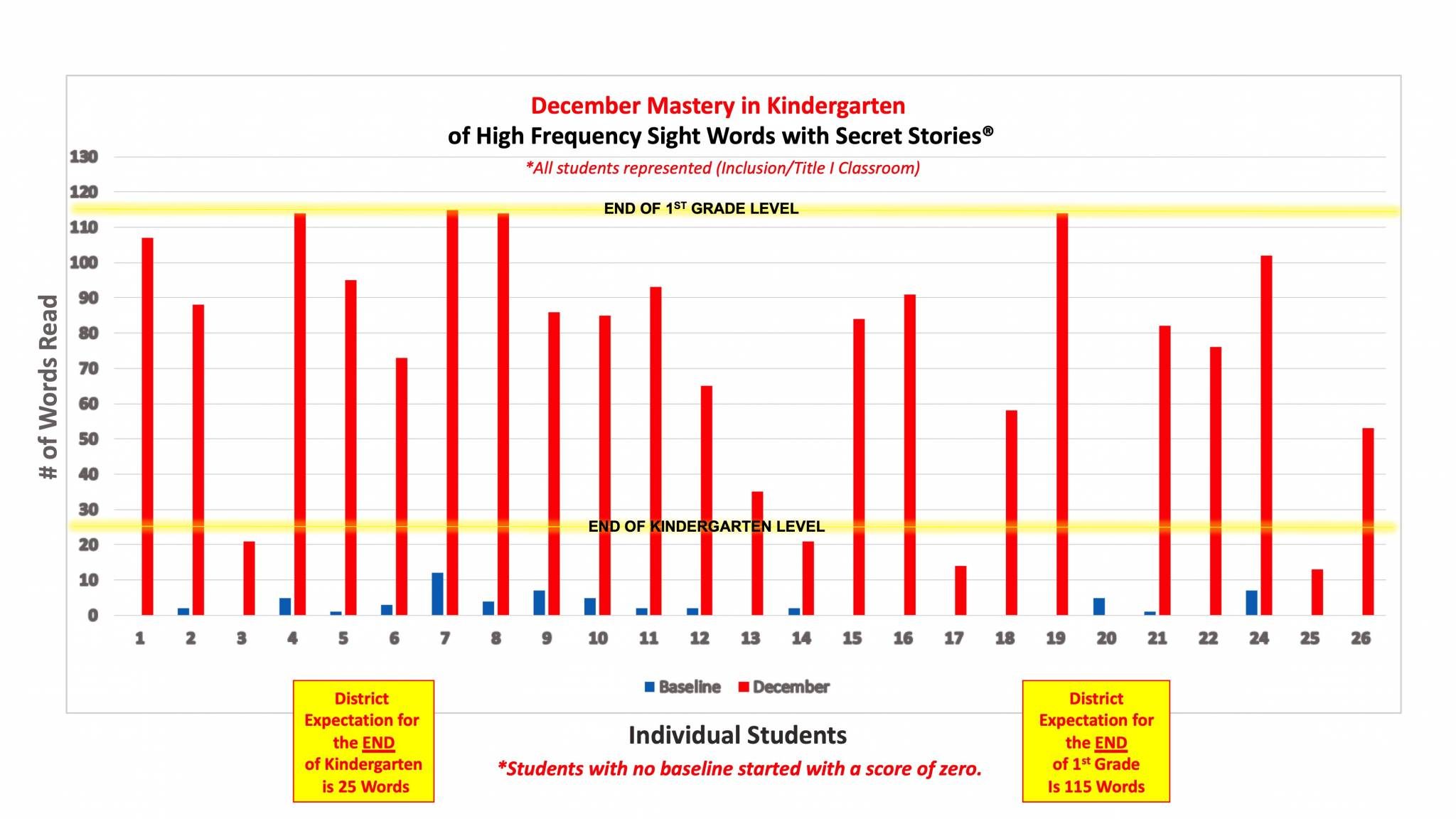
Writers Workshop
I’ve always loved using Secret Stories with Writers Workshop, as the two really do go hand-in-hand! Each day I do a mini-lesson and I model, model, model! Then, before students go back to their seats to begin their own writing, we spend a few minutes discussing what they notice in my writing—highlighting, circling, or using highlighting tape to mark all of the Secret Stories that they see. When they are doing their own writing, they are using the Secret Stories posters constantly.
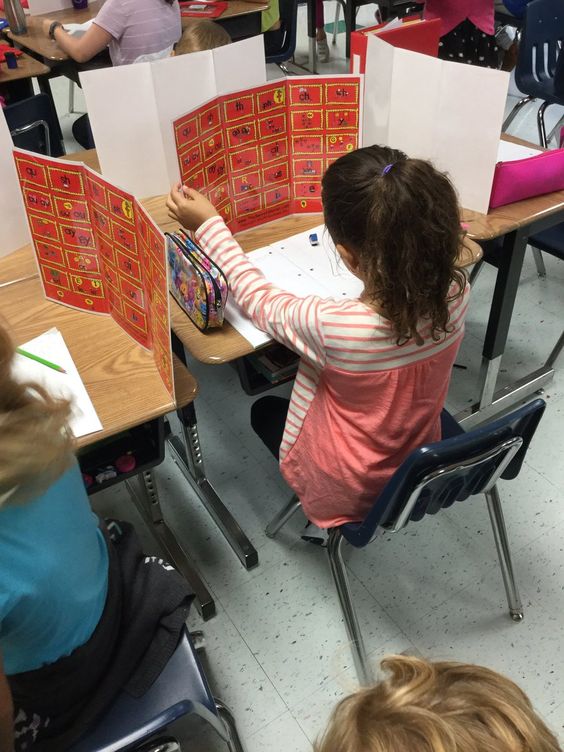
As they tap their arm to segment the sounds that they hear in each word, they know which Secrets make each sound, and can refer to the posters to see how to write it, or just to self-check. Each student also has a Porta-Pic in in their desk folders for easy access that they can refer to anytime they are reading or writing. Kids can take them home for reading and writing there (since they won’t have access to the posters) as well as to their resource/pull-out classrooms (for those who go).
The following video clips show our Writers Workshop time at the beginning of the school, as well as midway through the year. You will notice that at the beginning of the year, students focus more on drawing the pictures and just trying to get some letters down on the page, whereas by the end of the year, they are writing books.
Kindergarten Writing Workshop – Fall
Kindergarten Writing Workshop – Winter
Play-Based Learning & Phonics Fun
During center choice time, my students love to use the puppets and pretend to be the teacher teaching the Secrets. Recently, one student asked if we could make Superhero Vowel puppets. This led to an entire STEAM lesson, and ended with our making puppets for all of the Secrets, and even putting on our own puppet shows!
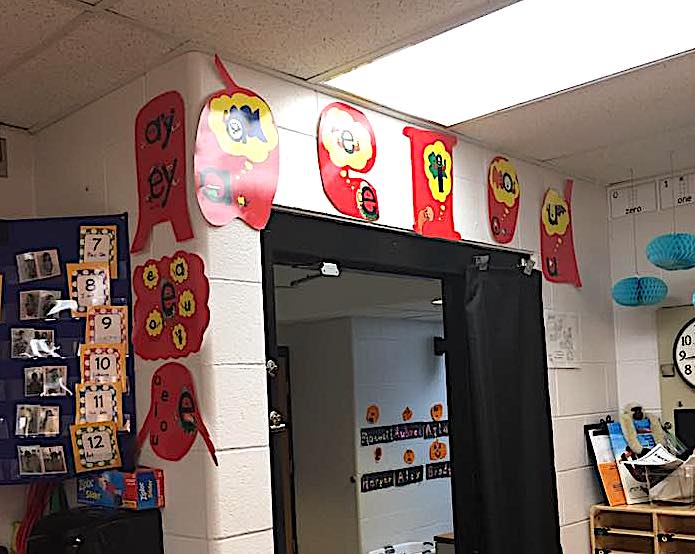
I divided students into groups of four, and each group had to design and create their own puppets using supplies from our classroom, and then create a skit. Once they made their puppets, they worked with their partners to rehearse their skits. Then each group presented their puppet show to the class. Once all of the skits were finished, students sat and shared their puppets and the sounds that they made.
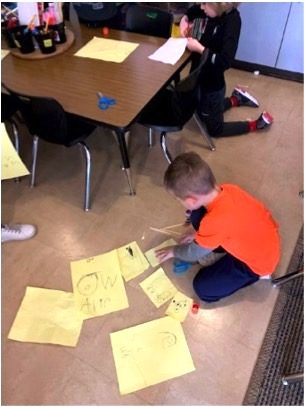
Play-based, cooperative learning is so much more valuable than any scripted lesson, not to mention a lot more fun! With the Secrets, kids already own the skills, so the real learning lies in their discovery of how to use them. In early grade classrooms, there are endless opportunities to “play” as readers and writers! And I believe that this is why the kids love learning the Secrets so much—because they give them more to play with! They associate the Secrets with fun, play, and stories!
Here are some short clips from our Secret Stories puppet-play—
/th/
/ch/ and /ed/
Digraphs
Short and Long Vowel Sounds (a.k.a. Superhero Vowels & their ‘Short & Lazy’ Sounds)
The 3 Sounds for Y (a.k.a. Sneaky Y®)
Reading Fluency
Reading fluency is key as phonics skills become second nature, and one way to encourage it is through song! We love to read, write and SING our way to fluency! First, we read a book about our favorite animal, then we write about it, and then we sing about it! Check out this talented little one sharing her “All About Animals” writing about raccoons, to the tune of “Party in the USA!” It’s adorable!!
As a teacher in a Primary K-1 building for over 13 years, when students would leave, I wouldn’t get to see them again unless they come back to visit. When they did, I would always ask them to read to us, and then I would let my little ones ask them questions. Once question that they always ask is, “What did you learn that helped you the most?” and the response is almost always, “Secret Stories.” I love knowing that I have given them a gift that continues to help them grow as readers and writers, long after they leave my classroom.
Teacher Expertise in Phonics Secret Stories
The best way to start Secret Stories is to jump right in and don’t overthink it!
Secret Stories give beginning grade learners easy access to all of the code they need to read and write long-before they will be formally introduced by your reading series or phonics program (as per traditional grade level scope and sequences). THIS IS NOT A PROBLEM—it’s a gift!
All you have to do is tell the story and then plug in its sound (for reading) or the letter patterns (for spelling/writing). Telling a Secret to explain strange letter behavior will never (I repeat, NEVER!) conflict with anything else you are doing—no matter what reading series or even phonics “program” you are using! It’s simply giving meaning to letters and sounds that would otherwise have none—and thus, would need to be repeatedly practiced as “skills” (instead of stories).
While Secret Stories is systematic and explicit with introduction of “most-needed” (highest-frequency) first, you can also share and use Secrets as you need them throughout the instructional day! Never limit them to just language arts time, because remember, they’re not a “program,” they’re tools for both you and your students! Secrets should never be taught in isolation, but immersed into everything that you do, and talked about everywhere you go (which kids will naturally do anyway whenever they see words!)
Remember to take advantage of every opportunity to make your students’ learning authentic, but don’t wait too long to introduce all the Secrets. And to all my fellow kindergarten teachers out there, DO NOT WAIT for kids to know the individual letter sounds before you start telling them Secrets! That’s like waiting for kids to learn Bob’s name before introducing them to Tabitha, just because her name has a /th/ in it!
With the Secrets, you can teach them together by singing the Better Alphabet Song (twice a day, every day, with “eye glue” and “muscle mouth!”) while simultaneously sharing Secrets! My class actually knew all of the Secret Stories before they’d mastered all of the individual letter sounds! This is because there is no learning curve for the Secrets, as kids get the stories (and their sounds) instantly, whereas the individual sounds are acquired through muscle memory, which can take anywhere from 2 weeks to 2 months with the Better Alphabet Song,
And most important of all, GET EXCITED! If you’re excited, then your kids will be excited! (This is actually the easiest part, as you won’t be able to help yourself!)
Children are like sponges, soaking up everything around them to grow. And my little sponges grew beyond my wildest expectations! All I had to do was feed them the Secrets, and then watch them grow into real-life readers and writers!
Melissa Gregory
Kindergarten Teacher
Melissajg24@gmail.com
PS Please leave any comments or questions below, and never miss a Secret (or a Secret-freebie surprise!) by subscribing to the Secret email blast here!
